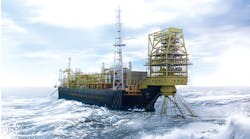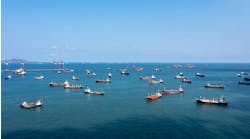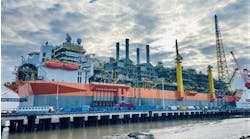Tracy Dulle - Technology Editor, Surface Systems & Vessels
With heavy-lift availability at a premium, the market is eager for alternatives to meet the demand. SeaMetric has launched an alternative heavy lift solution.
SeaMetric currently has two multi-purpose heavy-lift vessels under construction in China to be available to the market in late 2009.
SeaMetric’s new Twin Marine Lifter (TML) design is unique. It uses lifting arms rather than cranes, and will be able to lift 18,000-20,000 metric tons (19,842-22,046 tons) compared to the maximum lifting capacity of traditional heavy-left vessels at 14,000-15,000 metric tons (15,432-16,535 tons). Another factor that makes the TML system stand alone is the removable lifting arms.
“The lifting arms can easily be removed, giving flexibility for the vessels also to be utilized as construction support and heavy transport vessels,” says Bob Browning, commercial director for SeaMetric.
The TML system will have a DP-3 capability and include both accommodation facilities and a helideck. It will operate at wave heights of 3-4.5 m (10-15 ft) with low dynamic loads.
The operating cost is significantly less than a crane vessel, according to SeaMetric. The total cost for a small sized platform installation using SeaMetric’s TML is estimated at $8.5 million. For platform removal, a medium-size platform including a topside of 5,000 tons and a jacket at 3,000 tons would cost about $24 million with the TML, SeaMetric estimates.
The TML allows design of platform topsides for convenience of operation, not to fit within the crane’s lifting range. The vessel is designed for both removal and installation of platform topsides, jackets, subsea installations, boats, or similar objects.
With the global market for medium to large platforms (over 10,000 metric tons [11,023 tons]) estimated to be 30-35 installed per year and 30-40 removed per year from now forward, heavy-lift vessels are in high demand. Most of the heavy-lift vessels available would require multiple lifts to get the job done.
The market for removal or offshore installation over the next 20-30 years is at least 6,500 platforms worldwide, of which more than 1,000 weigh over 4,000 metric tons (4,409 tons), SeaMetric predicts.
As of January 2008, there were 59 heavy-lift vessels in the worldwide fleet with 100 ton (91 metric ton) capacity or greater, according toOffshore’s 2008 Worldwide Survey of Heavy Lift Vessels poster.
The current projected capex for a new 15,000-metric tons (16,535-tons) lift capacity crane vessel is about $1 billion, according to one builder. The current estimate to build the TML is $335 million, or $425 million with the addition of a heavy transport vessel (HTV).
When no heavy-lift work available, the TML can be reconfigured for other modes, such as heavy transport, piling, subsea intervention, construction support, and accommodation. The built-in skid system allows the lifting arms to be moved ashore for the reconfiguration.
How it works
The TML system is based on buoyancy and ballast tanks and lifting arms located on two identical vessels, each vessel being 140 x 40 x 10.75 m (459 x 131 x 35 ft).
The eight lifting arms weigh about 2,500 metric tons (2,756 tons), and are supported on a skid structure onboard the vessels. Each lifting arm is hinged to the skid structure over the center line of the vessel and is equipped with a buoyancy tank on the inside (between the barge and the object) and a ballast tank on the opposite side.
One TML with lifting arms is positioned on each side of the object to be lifted. The idea is to create a lift force by de-ballasting the buoyancy tanks and at the same time ballasting the ballast tanks. This is done by the use of seawater pumps.
The lifting arms can be positioned individually to accommodate differences between center of gravity and geometrical center.
Flexibility is built into the design of the TML system, with damped 15 m (49 ft) telescope function reducing axial forces in the system to a minimum and flexible main hinge absorbing the sway and pitch.
History
SeaMetric International was founded in March 2000, with the purpose of developing an environmentally friendly and cost effective marine heavy-lift system. Between 2000 and 2007, the company completed five successful model tests at Marintek.
The TML vessels received the DNV “Certificate of Fitness” in June 2006. Certification of the lifting arm system is ongoing.
In June of 2007, SeaMetric signed a contract with ESSCA (Hongkong) Ltd. in consortium with China Petroleum First Construction Corp. (CPFCC) for the overall project management, the construction of the TML vessels and lift arm system and for assembly and testing of the complete TML system. The two DP-3 heavy transport vessels will be constructed at the CNPC Liaohe shipyard.
Also in 2007, SeaMetric signed memorandums of intent with COOEC and Mexican-based Blue Marine Technology Group covering use of the TML System in northeast Asia and Latin America, respectively.
SeaMetric and COOEC will establish a new, jointly owned operating company for the first TML System, which will be delivered in late 2009.
SeaMetric and Blue Marine intend to establish a jointly owned marine operations contracting company based in Mexico, which will operate a TML system, transportation vessels, and associated equipment, for installation and removal of large offshore structures in Latin America.
In addition to the two DP-3 HTVs, forming the basis of the TML system, SeaMetric plans to build at least one 180-m (591-ft) long submersible HTV as part of each spread. These vessels will be similar to the vessels now being built in China for TML system No. 1, but will be bow-shaped, will have a larger accommodation facility, top speed of 15 knots, and will be submergible to 24 m (79 ft).
In February 2008, SeaMetric signed a memorandum of understanding with Fairfield Energy Ltd. for the removal and disposal of Fairfield’s present and future assets using SeaMetric’s TML system.
Later in 2008, SeaMetric plans to order, for delivery mid-2010, a TML system with similar specs to those currently under construction, and two HTVs to support lifting operations, that will be used to transport structures to be lifted to/from shore to/from the offshore location. The TML vessels are principally intended as platforms for the skid-mounted lifting arms.






